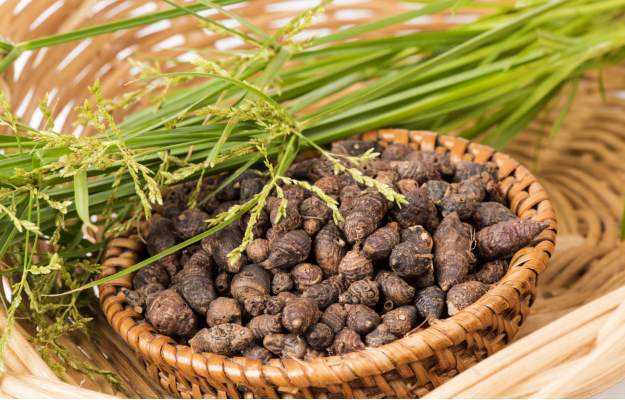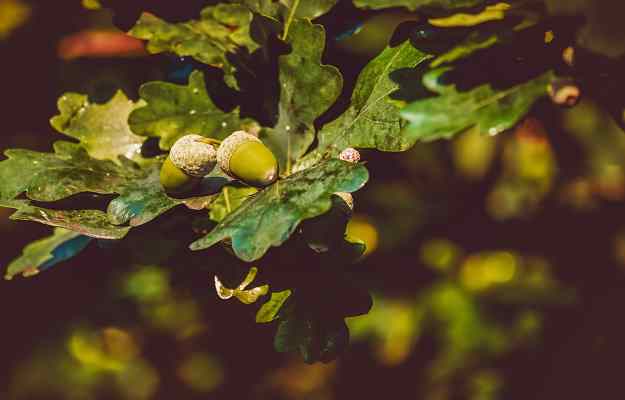Natural remedies in Ayurveda are finally getting some of the attention they deserve from modern researchers. One of the medicinal plants that have caught the attention of scientists in recent times is Nagarmotha or Cyperus rotundus, a weed that grows in many parts of the world—across tropical, subtropical and temperate countries.
Also known as purple nutsedge, nutgrass and java grass, Nagarmotha was prescribed in Ayurveda for stomach and bowel problems, pain relief and reducing inflammation. It was even said that applying Nagarmotha oil improved hair growth.
However, it is important to put traditional medicines to the test of modern science. In that spirit, this article is a snapshot of everything you should know about Nagarmotha if you are considering imbibing it:
Basic facts about nagarmotha:
- Scientific name: Cyperus rotundus
- Family: Cyperaceae (sedge)
- Parts used: Rhizome (modified steam), tuber, flower
- Sanskrit names: Bhadramusta, Granthi, Kachhda, Musta, Mustako, Sugandhi-granthila
- Common names: Nagarmotha, Gimbal (Marathi), Korai (Tamil), Tungagaddi (Telugu)
- Origins: India
- Geographical distribution: Grows in countries with tropical, subtropical or temperate climates.
In terms of appearance, the weed grows to a height of 7-40 cm. Its roots are fibrous and it reproduces mainly by way of rhizomes (modified stems). The rhizomes that grow downward into the soil form individual tubers which are prized for their smell—they release an essential oil that is used in perfumes and incense. The flowers produce phytochemicals that are used as natural insecticides.
Read on to know all about the health benefits and side effects of nagarmotha.
-
Health benefits of nagarmotha
- Nagarmotha (musta) for arthritis
- Nagarmotha for diabetes
- Musta (nagarmotha) for hair loss
- Nagarmotha (musta) for skin
- Nagarmotha for infections
- Nagarmotha for malaria
- Nagarmotha to prevent weight gain
- Nagarmotha for cancer prevention
- Nagarmotha for removing insects and worms
- Other therapeutic uses of nagarmotha
- Nagarmotha in Ayurveda
- Nagarmotha dosage and side effects
Health benefits of nagarmotha
There are many purported health benefits of nagarmotha. The benefits are attributed to the extracts of:
Rhizome of nagarmotha (musta)
- Antioxidant
- Wound healing
- Anti-pyretic or effective against fever
- Anti-diarrheal
- Anti-allergy or anti-histamine activity
- Anti-hyperglycemic (reduces high blood sugar)
- Anti-microbial (kills or fights germs) against Candida fungi and some viruses
- Anti-convulsant (read more: convulsions)
- Protects against ulcers
- Gastroprotective (protects the stomach) and hepatoprotective (protects the liver) activity
- Cardioprotective (protects the heart) and anti-hyperlipidemic (lowers high blood cholesterol)
- Neuroprotective effect (protects the nerves)
Tuber of nagarmotha (musta)
- Anti-inflammatory
- Anti-obesity, or helps in reducing body fat
- Anti-platelet activity
- Anti-diarrhoeal
- Anti-malarial activity
- Hypotensive activity (reduces blood pressure)
- Anti-emetic or prevents vomiting
- Anti-cariogenic property (prevents tooth cavities)
(Source: Plants in traditional medicine with special reference to Cyperus rotundus L.: a review)
Different parts of the nagarmotha plant have been found to contain chemicals that give the plant some of these properties. These naturally occurring compounds are:
- Essential oils derived from the rhizome containing chemicals like “α-copaene (11.4-12.1%), cyperene (8.4-11.7%), valerenal (8.7-9.8%), caryophyllene oxide (7.8-9.7%) and trans-pinocarveol (5.2-7.4%)” in some Indian varieties of the medicinal plant. Even within India, the chemical composition can vary depending on where it grows. According to an article published in the Journal of Essential Oil Bearing Plants, “The major compounds present in the essential oil of nagarmotha rhizomes were identified as cyperene, longifolin, caryophyllene oxide and longiverbenone. The amount of cyperene varied from 5.77% (Tilakgram, Madhya Pradesh) to 24.17% (Raipur, Chhattisgarh), longifolin varied from 5.95% (Raipur, Chhattisgarh) to 20.43% (Panna, Madhya Pradesh), caryophyllene oxide ranged from 2.42% (Padampur, Orissa) to 10.38% (Tilakgram Madhya Pradesh) and longiverbenone ranged from 3.96% (Padampur, Orissa) to 12.71% (Badarpur, Orissa).”
- Antioxidant flavonoids
- Terpenoids: a class of organic compounds known to have antimicrobial properties, anti-parasitic properties, anti-hyperglycemic properties (controls high blood sugar), anti-inflammatory properties and immunomodulatory properties
- Sesquiterpenes: there are many types of naturally occurring sesquiterpenes in different species of plants. Broadly, they are said to have including antibiotic, anti-tumour, antiviral, cytotoxic, immunosuppressive, antifungal, and hormonal activities
- Other chemicals like Aselinene, rotundene, valencene, cyperol, gurjunene, trans-calamenene, cadalene, cyperotundone, mustakone, isocyperol and acyperone.
Nagarmotha (musta) for arthritis
Triterpenoids may be responsible for the anti-inflammatory effects of nagarmotha, according to a study done with arthritic animals. Another study found that a methanol extract of nagarmotha could reduce the inflammation caused by nitric oxide and superoxide in arthritis. These effects need to be studied in humans, along with the safe doses, to properly reap any benefits of nagarmotha in arthritis, rheumatoid arthritis and other inflammatory disorders.
Nagarmotha for diabetes
According to a lab study, extracts of Nagarmotha rhizomes show “inhibitory activity against α-glucosidase and α-amylase, two enzymes involved in carbohydrate digestion”. For this reason, nagarmotha rhizome extract may help lower blood sugar and prevent diabetes.
Much more research and human trials need to be done to confirm this benefit.
Another lab study in rats showed that 500 mg/kg of nagarmotha extract, when given once a day for seven days, “significantly lowered the blood glucose levels. This antihyperglycemic activity can be attributed to its antioxidant activity as it showed the strong DPPH radical scavenging action in vitro.”
DPPH is 2,2-Diphenyl-1-picrylhydrazyl, a free radical that has been implicated in the damage caused by high blood sugar.
Musta (nagarmotha) for hair loss
An animal study with shaved albino rats showed that a concentrated extract of Nagarmotha could increase follicle size and prolong the active growth phase (anagen) for hair. The researchers said it could be a potential treatment for “Indralupta”—the traditional medicine name for alopecia.
Nagarmotha (musta) for skin
Animal studies in preclinical research showed that chlorogenic acid in nagarmotha had anti-inflammatory action and could therefore help in conditions like acute or chronic dermatitis. However, more studies and human trials need to be done to confirm this benefit in people.
Some researchers have even argued that valencene—a type of chemical found in nagarmotha rhizome extracts—could prevent signs of photoageing (skin ageing due to sun exposure) like wrinkles, by interfering with some mechanisms (calcium ion channels) responsible for these skin changes. Having said that, the researchers themselves pointed out the need for further research into the uses of nagarmotha as an anti-ageing solution. (Read more: Causes of wrinkles and some home remedies to get rid of them)
Nagarmotha for infections
Research has shown that nagarmotha (musta) may have antibacterial and antifungal properties. In one study of essential oils from the tubers of C. rotundus grown in Tunisia, it was found to be most effective against S. aureus bacteria that can cause skin infections including abscesses, respiratory infections like sinusitis and food poisoning.
More research and trials need to be done to establish this in humans and the safe dosage for it.
Nagarmotha is an ingredient in a herbal formulation called Amrutadi kwatha which is used in the Ayurvedic treatment of herpes simplex virus infection, osteoarthritis and rheumatoid arthritis, among other diseases.
Nagarmotha is also an ingredient in Mahamarichyadi taila which is an Ayurvedic remedy for ringworm infection.
Nagarmotha for malaria
Though malaria is a type of infection, it is usually talked about separately because it affects so many people in India—World Health Organization data show that India accounted for 86% of malaria deaths in the WHO South-East Asia Region in 2019. Research attributes the “antimalarial” activity of nagarmotha tubers to the presence of chemicals like:
- Patchoulenone
- Caryophyllene or-oxide
- 10,12-peroxycalamenene
- 4,7-dimethyl-l-tetralone
Also, a decoction made with the rhizomes of nagarmotha, stems of Guduchi and dried ginger is said to bring down the fever in malaria.
Nagarmotha to prevent weight gain
This effect of musta (nagarmotha), too, seems to have been studied in animals only, so any claims to the same should be taken with a pinch of salt until more research and data become available.
In a lab study, obese Zucker rats were given hexane extract of nagarmotha tubers for 60 days, in one of two dosages:
- 45 milligram per kilo of body weight per day (mg/kg/day)
- Or, 220 mg/kg/day
The extract was seen to induce “significant reduction in weight gain without affecting food consumption or inducing toxicity”
Further, the researchers surmised, the plant may contain chemicals that promote fat loss.
Nagarmotha for cancer prevention
Research has found that Cyperus rotundus and Cyperus scariosus (umbrella sedge)—two morphologically different plants of the same family, grown in different soil conditions—may prevent oxidative damage and up-regulate the expression of connexin cell-adhesion protein, to guard against some types of cancer including liver cancer. However, this research was done on mice and was limited to an herbal medication in which Nagarmotha was one of the ingredients. Many more studies need to be done to confirm this.
Nagarmotha for removing insects and worms
A study found essential oils from the tubers of Nagarmotha could kill the eggs and larvae of Aedes albopictus mosquitoes. The researchers concluded that the plant could become a source of natural mosquitocides.
In another study, the hexane extract of Nagarmotha tubers was found to be more effective than DEET (N, N-diethyl-3-methylbenzamide) for repelling Anopheles culicifacies, Anopheles stephensi and Culex quinquefasciatus mosquitoes that are carriers (vectors) for diseases like malaria and lymphatic filariasis.
Another study found that Nagarmotha is almost as effective as organophosphate and better than for killing ants.
The essential oil from tubers is also used in insect repellants.
Other therapeutic uses of nagarmotha
The essential oil from tubers is also used in:
- Perfumes and soaps
- For bringing down fever in malaria and typhoid. For typhoid fever, a decoction of nagarmotha rhizomes, the leaves of Fumaria indica (pitpapra), Swertia chirayita, black pepper and ginger is said to be helpful.
- For constipation, thrice daily intake of 25ml juice of nagarmotha rhizome juice is said to help. Dysentery patients and people with stomach problems were traditionally given a mixture of scraped and pounded nagarmotha rhizomes, green ginger and honey.
- In order to increase breastmilk production, the direct application of fresh nagarmotha tubers was advised in traditional medicine.
All of these purported benefits need to be tested through rigorous research and study. Please do not use these remedies without consulting a doctor, and do not consider these a substitute for a doctor’s visit, diagnosis, tests of treatment for any of these conditions. Additionally, if you are taking medicines for a health condition—whether it is acute or chronic—check with your doctor before pairing herbal remedies with any other medicines. Remember that studies on how these remedies interact with medicines have not been done for the most part.
Nagarmotha in Ayurveda
Plants and herbs have a very prominent role in Ayurvedic medicine. According to one estimate, there are 2,559 plants in use in Ayurveda—the only other Indian alternative medicine system with more plant species in use is folk medicine with 6,403 species of plants.
Nagarmotha is said to have originated on the Indian subcontinent and was used in traditional medicine for:
- Digestive issues
- Dysmenorrhea or painful periods
- Fever
In other traditional medicine systems, it was also used to prevent dental caries (cavities)—research has shown that some varieties of this plant can be active against Streptococcus mutans bacteria.
Present-day research may act as a:
- Diuretic (something that increases urine production in the body)
- Carminative (something that reduces farting or flatulence)
- Emmenagogue (something that stimulates or improves menstrual periods)
- Anthelmintic (something that kills stomach worms)
- Analgesic (something that relieves pain)
- Anti-inflammatory (something that reduces inflammation)
- Antidysenteric (something that prevents or relieves dysentery)
- Antirheumatic (something that provides relief in rheumatic conditions like inflammatory arthritis)
- Protects against cancer by inhibiting ras oncogene-linked cell transformation
More research needs to be done on this, including on how to use nagarmotha and its potency and dosages to get these uses out of it.
Nagarmotha dosage and side effects
The correct dosage would depend on your condition and weight. Please consult an Ayurveda or Unani doctor before taking nagarmotha for any health condition. Also see your general physician and ask about potential interactions with your current medication.
No significant side effects have been recorded for nagarmotha yet. However, keep in mind that herbal medicines sold in the market can have a much higher concentration of nagarmotha phytochemicals than the naturally occurring plant. Ask your doctor before taking any nagarmotha-based medication.
Find Ayurvedic Doctor in cities
Doctors for Nagarmotha benefits and side effects

Dr. Ayush Bansal
Ayurveda
2 Years of Experience

Dr. Megha Sugandh
Ayurveda
6 Years of Experience

Dr. Nadeem
Ayurveda
3 Years of Experience














